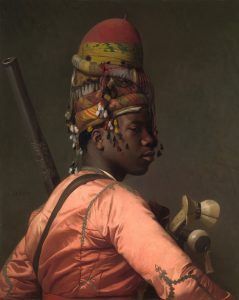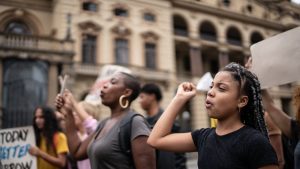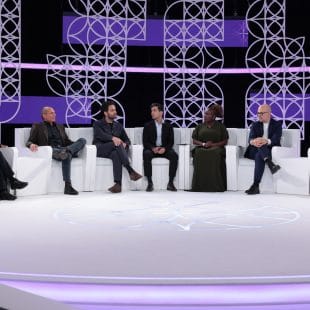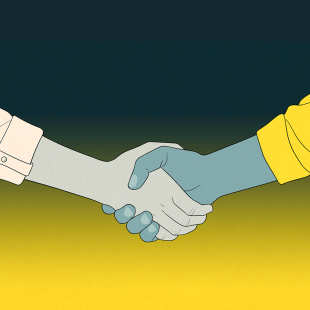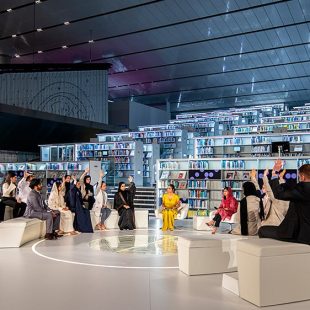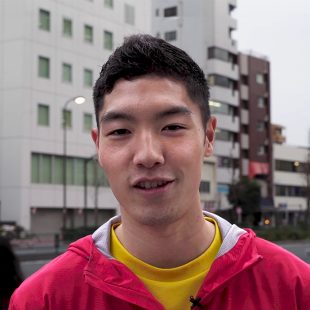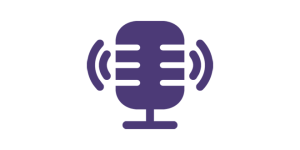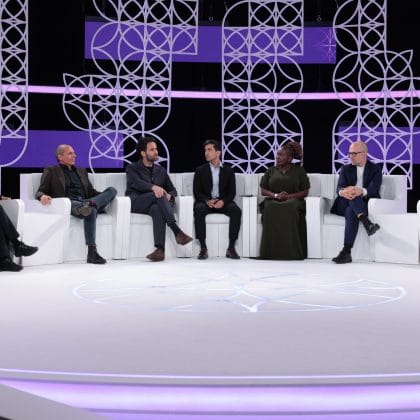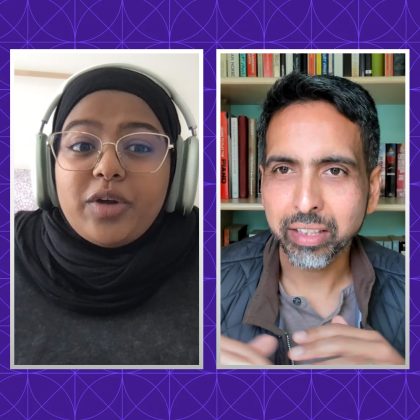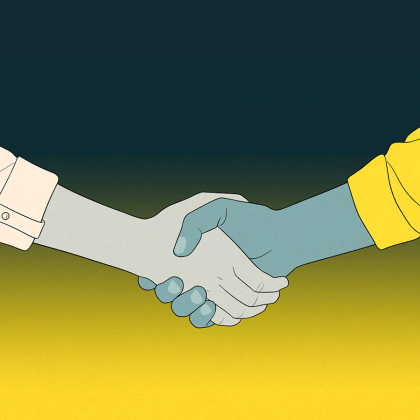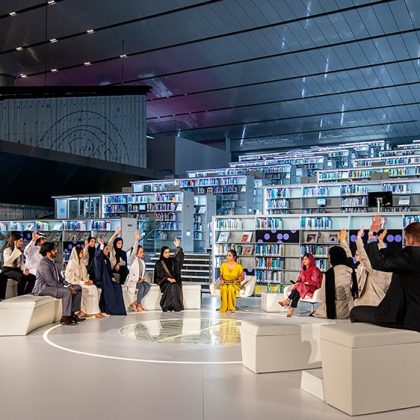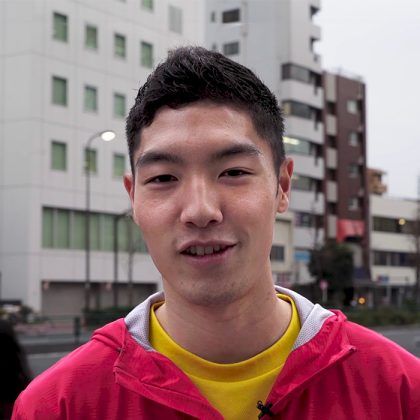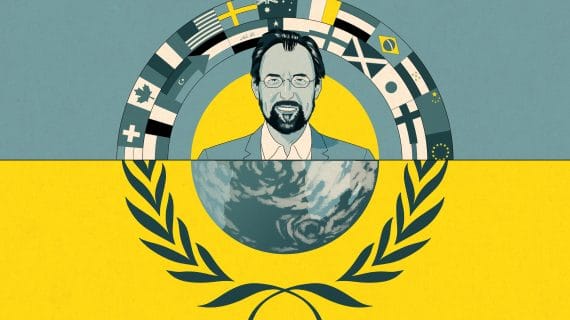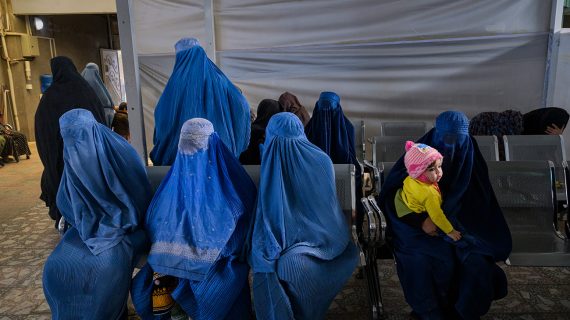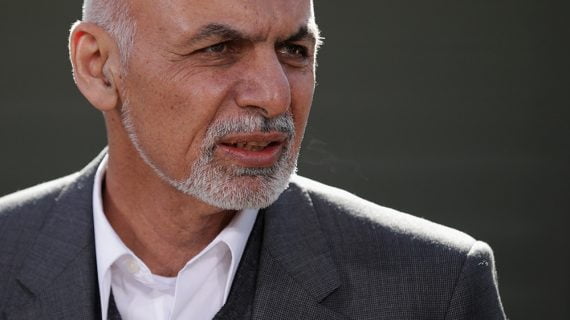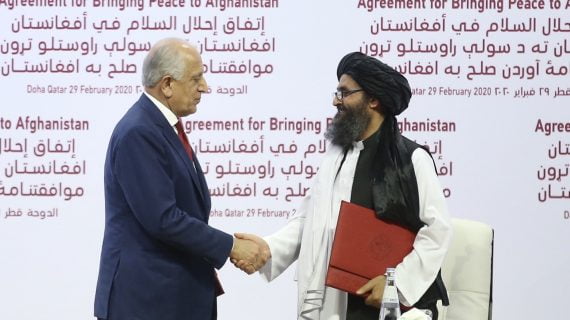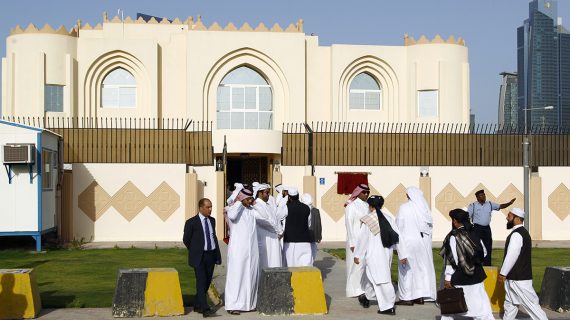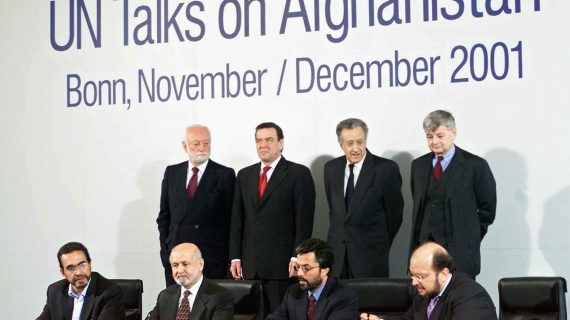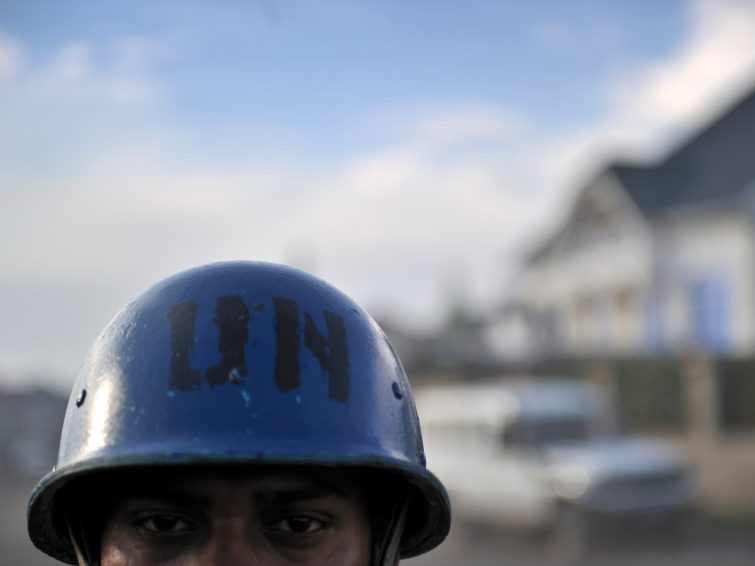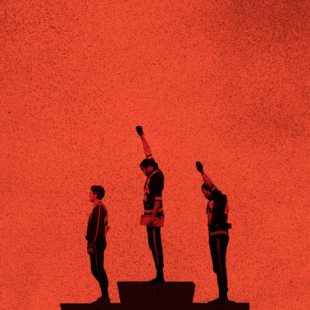For the first time in US soccer history, the men’s and women’s national teams are getting paid at the same rate. That’s the result of a grueling negotiation that ended last year, led by Cindy Parlow Cone, a former professional player who became the US Soccer Federation president.
Cone speaks with producer Karen Given and describes how far apart the two sides were at the start and how they reached an agreement.
The Negotiators is a collaboration between Doha Debates and Foreign Policy.
Full Transcript
Note: We encourage you to listen to the audio if you are able, as it includes emotion not captured by the transcript. Please check the corresponding audio before using any quotes.
[SUSPENSEFUL INSTRUMENTAL MUSIC]
JENN WILLIAMS, HOST:
Hey everyone. Welcome to The Negotiators, a production of Doha Debates and Foreign Policy. I’m your host, Jenn Williams. Today we are excited to feature a negotiation that’s totally different from what we usually cover. It’s about gender parity, a really big and important issue. For the first time in US soccer history, the Men’s and Women’s National Teams are getting paid at the same rate. That’s the result of a grueling negotiation that ended last year, and it’s due in part to the efforts of one person in particular. Cindy Parlow Cone is the first female president of the US Soccer Federation.
CLIP OF AMERICAN WOMAN SPEAKING:
She’s not only a thoughtful player, she’s a thoughtful human being. She’s smart, she’s savvy. She just …
JENN: Cone was also a big star for the US Women’s National Team. She won two Olympic gold medals, and she played on the 1999 team that won the Women’s World Cup. So she’s been in the game a long time, but when Cone began her role as the head of US Soccer, it was complicated. Her first day was March 12th, 2020, the same day that many US businesses shut down due to COVID. Cone spoke with one of our favorite producers, Karen Given. She’s the executive producer of The Long Game, another podcast from Doha Debates and Foreign Policy. OK, Karen will take it from here.
KAREN GIVEN:
So, the first thing I want to do is, I want to take you to the week before you stepped into the job as president of US Soccer. You have said, “Our sponsors were outraged, our fans were outraged, our players were outraged.” So remind us: what had US Soccer done to make everyone so angry?
CINDY PARLOW CONE:
This was a really challenging time for US Soccer. I was vice president, and we were in this equal pay litigation with the Women’s National Team. And US Soccer had filed a legal brief, and in this brief there was very offensive language comparing the men’s team to the women’s team, and basically—I’m paraphrasing here—said that women were inferior to men.
NEWSCLIP WITH AMERICAN WOMAN SPEAKING:
In the document, US Soccer said that men’s team players have more responsibility, and that biological differences mean men have a higher level of skill based on speed and strength than women.
NEWSCLIP WITH AMERICAN MAN SPEAKING:
Biological science is the reason why men should make more money than the women? You’ve got to be kidding me.
[NEWSCLIP OF PANEL WITH MULTIPLE SPEAKERS]
MALE PANELIST:
I can’t believe US Soccer actually put these arguments on paper—
FEMALE PANELIST:
[LAUGHING] I know!
[UNINTELLIGIBLE CROSSTALK BETWEEN SPEAKERS]
MALE PANELIST: On paper, in court.
FEMALE PANELIST: In court!
MALE PANELIST: It’s just … you know.
CINDY: Obviously this was massively offensive to everyone. Our players were rightfully outraged. Our sponsors were outraged. I think every woman was outraged. I was outraged. It was just this really awful time at US Soccer. And so, the president resigned shortly after that legal brief was filed, and so, literally, I became president at that moment.
KAREN: Yeah, so the previous president, Carlos Cordeiro, he resigned, at least from my perspective—I saw the tweet at, like, nine o’clock at night. So is that when you found out, and what was it like that evening? Did you get any sleep?
CINDY: [LAUGHS] I found out at that moment as well, and, you know, I’ll be honest, I was freaking out. [LAUGHS] You know, I think I had—it’s probably the typical female response. My immediate response was, like, I was thinking about all the things that I wasn’t, and that I hadn’t done. Like, I don’t have an MBA, I haven’t led a Fortune 500 company. I’d never held an executive position in a company before, and so—and I’m not going to lie, that lasted for a little bit. [CHUCKLES] But you know what I really relied on was my playing career, and all the lessons that I had learned there. And I thought about when I was 17 years old and I joined the national team. And I joined this team, and I was like, OK, how do I fit in here? Right? Like, I’m no Mia Hamm, I’m no Michelle Akers, I’m no Briana Scurry. Like, how am I on this team? But as I became president, I was like, OK, yes, I don’t have all those things, but what do I have? What do I bring to this position, and how am I going to build this team and empower this team, because we have so many challenges in front of us, and I knew full well I couldn’t do it by myself. But I’m really proud of where we are and where we’re headed.
KAREN: I want to talk a little bit more about your time on the national team. So you showed up at 17 years old. I can only imagine that you were happy to be there. Were you aware that the rumblings of this fight had already begun?
CINDY: I was aware of the rumbling. So we were heading into the ’99 World Cup. They wanted to put us in small stadiums. We were fighting for bigger stadiums, and quite honestly, we didn’t know if people would come. But it was just such an amazing time, an amazing group of women to start this battle with, and to really start to form my education on the topic.
We looked to the federation, and it always was this sense of the players versus the federation. We called them “the suits” and “the blank feds.” Like, there was just this friction, a ton of friction, and for me, I wanted to get rid of that. Not that we’re not going to have disagreements, there’s always going to be disagreements. But I wanted to shift it and be like, even if we don’t always agree on things, that we’re on the same team, we have the same goals. Because now, being on the federation side, having lived the athlete side, player side, so I know where they’re coming from with the women’s team. I know where their rage is coming from, where the passion is coming from. Taking that together with what I know from the federation side, and being able to put these two together and like: OK, I get both sides. How do we do this?
KAREN: Less than two months after you came onto the job, the court threw out the bulk of the women’s equal pay lawsuit. The women did say that they would appeal, but I feel like your predecessors would’ve said, “Great, the court is on our side. That means we don’t need to negotiate anymore.” Why did you decide to stay at the table?
CINDY: Yeah, for me, it was bigger than the litigation. You know? Regardless of what the courts said, it wasn’t going to fix the issue that we had. And so for me, even though the judge ruled in our favor, that wasn’t going to help resolve equal pay, that wasn’t going to help us build a better relationship with our, with our players. It wasn’t going to help us grow our brands, bring on new sponsors, have new media partners. And so for me, it was about the bigger picture. We weren’t going to be able to realize any of these dreams about growing our game and making soccer accessible to every kid that wants to play it if we don’t have the players in the same boat with us. Right? If that friction continued, we weren’t going to be able to go out and do the big things that we want to do.
KAREN: Obviously, building trust was a huge part of this, right? You started from a place of so little trust. Talk me through, like, the specifics of what it looks like to reach out to people and start building that trust that’s been so broken in the past.
CINDY: Yeah. Well, it started with the Women’s National Team, because they were very clear from the beginning that they did not want to have any direct conversations with me or any staff members at US Soccer about the litigation. They wanted everything to go through their lawyers. So I obviously 100% respected that. Rebuilding trust takes a while, and so for me, it’s about showing up, saying what you’re going to do and doing it, because I knew, as a player, that those things didn’t always happen. And so while I couldn’t talk directly to the players about the litigation and wanting to solve it, what I could do was everything outside of it. And then one day the players called me up and wanted to talk about the litigation, and I was like, hallelujah! [LAUGHS] I mean, that was a true turning point in the litigation, and I don’t know if that happens if we hadn’t done all the things before. I think I had built that trust, and so now they felt comfortable enough with me to—being able to move forward from there.
KAREN: So this podcast is all about—how do you bring people together who have different points of view and get them all on the same page? So I want to talk about how it actually happened. How do you even start that process?
CINDY: Yeah, I mean this was a long process. So I came on as president in March 2020, and I was like, “I’m going to resolve this! I’m going to figure this out. Like, no problem. I was on the women’s side, I got this, I now understand the federation side. I’m going to—I’m going to solve this.” It was not that easy. [LAUGHS] There were so many meetings, so many conversations, phone calls, Zooms, in-person meetings, drafts exchanged, proposals. There was mediation. We were trying everything.
One of the challenges that US Soccer had always had, before my time as president, was that the different cycles of when the men’s contract was up, and then two years later the women’s contract would be up and two years later, the men’s contract—and so there was always one contract being negotiated, completed, and then the next one. We were negotiating with the men’s national team to do their CBA—and that’s collective bargaining agreement—at the same time that we’re trying to settle the Women’s National Team litigation. And then, when we weren’t really progressing at the pace that we wanted to, we kind of put a hold on and was like, “Wait, we have this moment in time. Our women are about to be out of contract. Our men are out of contract. And we can do the same contract.”
KAREN: A big stumbling block in all of this has always been FIFA World Cup prize money. So explain that to me. What is it about this issue that made an equal pay deal so difficult to negotiate?
CINDY: Yeah, so in 2018, that was a Men’s World Cup year. The World Cup champion received, from FIFA, 38 million dollars. A year later, the Women’s World Cup comes along—so 2019 World Cup—and our Women’s National Team wins, and FIFA Awards them four million dollars. This was the crux of the litigation that was against us, in that the FIFA World Cup prize money was different, and the women wanted to be paid what they would’ve been paid had they won the Men’s World Cup, and feeling that that prize money should be the same. And I kind of had to put a line in the sand and say, you know, “We are not going to sign CBAs that do not equalize World Cup prize money. So we need to figure this out together. The men’s team and the women’s team, you guys can figure it out and come to us, we can be a part of the conversation, but there are not going to be new CBAs without the equalization of World Cup prize money.” And I think that was kind of a turning point in the conversation to get the men to really realize how serious we were about this, because if we didn’t figure out how to equalize World Cup prize money, we were never going to resolve equal pay. There was just no way to do it.
KAREN: Why didn’t you just say, “Oh, I’m not going to resolve this with my players. I’m going to pressure FIFA to resolve this instead, because this is FIFA’s problem”?
CINDY: Well, I think that had been the approach that everyone had taken before, and it wasn’t getting resolved. And so we had to figure out, OK, how do we best solve this? And at the same time, keep encouraging FIFA to equalize the World Cup prize money between the men and the women’s World Cup? That is why we needed the help of the Men’s National Team, to come together and basically pool the World Cup Prize money and split it.
KAREN: On February 22nd, 2022, you joined US Women’s National Team players Megan Rapinoe and Alex Morgan on live TV, and you announced that the lawsuit had been settled. US Soccer agreed to pay the players 24 million dollars, and promised to equalize prize money for all competitions including the World Cup. This was obviously very big news,
NEWSCLIP WITH AMERICAN MAN SPEAKING:
Big win for the US Women’s National Team Tuesday morning, and they didn’t even have to step on the pitch.
NEWSCLIP WITH AMERICAN WOMAN SPEAKING:
This is a seminal moment for not just female athletes, but for women everywhere …
NEWSCLIP WITH CINDY PARLOW CONE SPEAKING:
You know, the justice comes in the next generation never having to go through what we went through. It’s, it’s equal pay across the board from here on out, and I’m looking forward to continuing to grow the sport …
KAREN: You weren’t done yet. Why not?
CINDY: The litigation was more looking back, right? So most of it is FIFA World Cup prize money that had been awarded prior, and so how do we resolve that? I wanted to solve equal pay forever. [LAUGHS] And I think everyone did. And so we linked the litigation settlement that we—all sides agreed on to the signing of the CBAs. So the settlement would not come through until we had figured out how to basically solve equal pay forever and get to CBAs the men’s team agreed to, the women’s team agreed to and US Soccer.
JENN: So how do Cone and the other US Soccer negotiators solve equal pay forever? Find out after the break.
[LIVELY INSTRUMENTAL MUSIC]
JENN: Welcome back to The Negotiators, A partnership between Doha Debates and Foreign Policy. I’m Jenn Williams. Before the break, US Soccer just settled an equal pay lawsuit with the US women’s soccer team, and now, they’re finalizing new contracts with both the men’s and women’s soccer teams. Karen Given, our reporter for this episode, takes it from here.
KAREN: I don’t want to give the impression that you waited until the lawsuit was settled to start working on the CBAs. Those negotiations were definitely taking place simultaneously. But when it came to the collective bargaining agreements with these two teams, what was your goal?
CINDY: For me, like, going through these negotiations … I always had in the back of my mind, “We are going to get to one contract. We need one contract.” And I failed on that. [CINDY AND KAREN LAUGH] But I, but I gave it up for good reason. There were just certain things that were really important to the Women’s National Team that wasn’t important to the Men’s National Team and vice versa.
KAREN: You say that the women and the men wanted some different things. Can we get specific on that?
CINDY: Yeah, I mean, like—it was small things, really. For instance, the women wanted more massage therapists. And the men didn’t care as much about a massage therapist; they wanted a chiropractor, for instance. You know? They just wanted different things in terms of the staffing of their camps. And so, there were little things like that that had to be worked through to make sure that the number of staff support were the same, even if the roles and the titles of what each team wanted was different. But for me, and I think for everyone, it was really important that compensation-wise, everything was the same.
KAREN: I read somewhere that you invited men to sit in on the women’s negotiations and vice versa. How did that come into being?
CINDY: Yeah. ‘Cause as we were talking to one, it would be like, “Oh, well, we heard you did this with the men’s team,” or “We heard you did this with the women’s team.” And I’m like, “OK, let’s, let’s stop this.” Like, full transparency, right? Like, we’re not trying to negotiate in secret. We’re not trying to do anything nefarious. Let’s be open and transparent. And so, inviting the Men’s National Team PA to the negotiations when we’re negotiating with the women, and vice versa. And then that moved from, OK, let’s all get in the same room together and figure this out. Like, we have a slogan: “One nation. One team.” Like, if we’re truly going to embody that, we had to get all the oars that everyone was holding rowing in the same direction. And, you know, they were going in all different directions when we started this, and some were just stuck in the water and not moving, you know? [CHUCKLES] And to do that, there has to be a—much more trust and a lot more transparency. And so that was my whole goal with that.
KAREN: I’m hoping to get some sense of these rooms that you were meeting in. I understand they’re in DC, maybe in Chicago. So take me into the room visually. Is it crowded? Is it a few people around a table? What does it look like?
CINDY: Well, there’s different rooms. There’s virtual rooms and then there’s in-person meetings. So quite honestly, the most stuff got done in person. And so usually the setup was we would have, like, a big boardroom—everyone’s seen them, big long table, lots of chairs around it. And then each group would have their own breakout room, depending on the topic of the day and what we were negotiating. We would all go into the big board room, talk about it, and then something would come up and we were like, “OK, well, we need to work on this part. You guys work and figure out that, you guys work and figure out that, and then we’ll come back together and see where we are.” I had a CBA negotiating committee as well, so maybe I needed to check in with my CBA negotiating committee. Maybe I needed my finance person to run numbers on a certain proposal and what that meant, you know, and what did that mean to our bottom line. Or I was like, “I need to talk to my board. I can’t move forward with this without getting input from my board.” And so, I’m sure the Women’s National Team and their PA had their own process they had to go through, and the Men’s National Team and their PA as well. And so we go to the breakout rooms, we solve all the world’s problems, come back together. [LAUGHS] Present it, create new problems, go back out again. And so it was just this, this long process.
KAREN: There’s one thing you did that, sort of, US Soccer hadn’t done publicly before, which is you started saying to the media, “The men have the power to make this happen. They say they support the women, they have the power to really do it.” Was that a conscious decision?
CINDY: Yeah, I don’t think that was in my talking points. [CINDY AND KAREN LAUGH] I think it just came out there, but it’s the honest truth, right? I couldn’t do this alone. I could not force this. I had to have buy-in from our Men’s National Team and their players association in order to get equal pay in the CBAs. Because US Soccer isn’t, and wasn’t, in the financial position to make up the difference in FIFA World Cup prize money. Now I’ll continue to work with FIFA to try to equalize that prize money, and we’ve heard recently that they’re looking to equalize it in ’26, ’27, and I’m very hopeful that that’ll happen, but I knew that US Soccer and I, personally, couldn’t do this alone. That if we were truly going to reach equal pay and equalize FIFA World Cup prize money, I had to have the men at the table and they had to agree to do it.
KAREN: The other thing you negotiated was a revenue share. So it’s not just tournament prize money that’s pooled and divided equally. It’s also a share of broadcast revenue, event revenue, and sponsorship dollars. Why was this an important part of the negotiation?
CINDY: The revenue share really put us all in that same boat, right? And so with revenue share, if the federation is doing well, it helps the players, and as the players do well, it helps the federation, because it helps us go out and get more partners and sponsors and such. And so I think this is an often overlooked part of the CBA, but something that was really important to me as we’re going out to get a new partner, a new sponsor, signing them on—the players are a part of that now. So they get a portion of what we bring in, and then obviously, it’s helpful for us if our national teams are performing really well. And so as they do well, it helps us do well, and as we do well, it helps put money in their pockets, right? And so it was a great way to really show that we’re on the same team.
KAREN: So how did something like the revenue share—how did that get negotiated?
CINDY: Yeah, there was a lot of back and forth. I think the revenue share took a, a little bit of work to get buy-in from our board, but to settle on what that percentage is took a lot longer, in trying to figure that out, in trying to figure out what makes sense and what number, as a federation, are we comfortable with so that we can still go out and do the things that we want to do—not just with the men’s senior and women’s team, but we have 27 national teams, and we have to have programming for all of those teams, as well as we have a large membership. I think that was most of the back and forth, was trying to figure out on what that revenue percentage should be.
KAREN: I heard that you had a conversation in a hallway with Becca Roux, executive director of the Women’s Players Association, and after that conversation, you both walked into the negotiating room so confident that a deal was going to get done that Becca said, “We’re going to take a picture at the end.” Is that how you remember it?
CINDY: Yeah. So, you know, when you get a lot of lawyers in the room—and no offense to any lawyers listening, they are fantastic, I love all of our lawyers—but there’s times when you just need, like, non-lawyers to have moments of, “We got to figure this out.” I was speaking in the hallway to the players association, and it was like, “OK, we have to do this, and this is why. How do we get there? How do we figure this out? Help me figure this out.” And we sat together and basically hammered it out and then got back to the big room. We all agreed to terms, and we all took a picture after the negotiations and we were all excited. And then a few weeks later, it was like, “Well, what about this?” And I’m like, “Oh no, we took the picture!” [CINDY AND KAREN LAUGH] We figured it all out in the end, obviously, but it just goes to show, like, I mean, this wasn’t easy.
KAREN: Take me to the moment when you have an agreement in place on the CBAs, but then it has to go to both of these players associations and they have to vote on it. So what was that like?
CINDY: Yeah, it had to go to both of them and it had to go to my board as well. [LAUGHS] With the Women’s National Team, we were pretty confident, because as I said before, the players were at many of the meetings, so we knew how they felt about it. The Men’s National Team, we weren’t as sure about, we didn’t have as much confidence in, because we hadn’t interacted directly with the Men’s National Team in dealings with the CBA. That was a little question, and then my board, as well. I wasn’t sure where they were going to come out. You know, this was a lot of money that US Soccer was putting into the CBAs, which meant we were going to have to grow the pie if we were going to be able to do all the programming that we wanted to do, and reach the goals that we wanted to reach as US soccer. And so I give a lot of credit to our board. They were all in.
KAREN: Do you remember what you felt when the last vote came in?
CINDY: Relief. [LAUGHS] I didn’t want to do this all over again. Or any longer. [LAUGHS] It was just relief, you know, that we had finally done it. But this also still, remember, the litigation was hanging in the balance. So the litigation still had to be approved by the court, so it was all—it was all kind of a little bit of a waiting game. But, you know, like, sitting on Audi Field, signing the CBA and celebrate this really historic moment, there were so many people that were a part of this that helped push this across the line. And just the fact that the men were like, “OK, this is the right thing to do,” was huge. The Women’s National Team continue to come back to the table to continue to fight, to help give me a voice to go to FIFA, and like, “This is what we’ve done. And here’s how I would like for you to help us resolve this moving forward.” Things are progressing, which for me is very exciting. I’m so proud. I’m so proud of where we are. I’m still a little annoyed that it took so long, you know? [CHUCKLES] I really joined the fight in around ’99, so … been in this fight a long time, but a lot of exciting things ahead.
KAREN: What are the biggest lessons you take away from this whole process?
CINDY: Oh my God, so many. I’m a pretty patient person, but my goodness, did this challenge my patience. [LAUGHS] It just—everything took so much longer than I wanted it to take, and then I felt that it should have taken. I think that was one real challenge for me. You also have to remember, like, I was a pretty new president, pretty new executive doing this. I think one thing that surprises people about my leadership is I am always willing to admit what I don’t know. [CHUCKLES] They were doing financial models after financial models, and financial models of financial models. I mean, it was crazy, and in parts of it they got so deep I was like, “OK, can you explain what you just did here for me?” ‘Cause I guess a lot of leaders don’t say, like, “I don’t know anything about that. Can you help me here?” I’ve realized how important of a leadership skill saying “I don’t know” really is. [CHUCKLES]
JENN: That was a conversation between Karen Given, executive producer of The Long Game, and Cindy Cone, president of the US Soccer Federation.
The Negotiators is a partnership between Doha Debates and Foreign Policy. Our production team includes Rob Sachs, Ashley Westerman, Rosie Julin, Claudia Teti, Japhet Weeks, Jigar Mehta, Amjad Atallah and Dan Ephron. Laura Rosbrow-Telem is the show’s senior producer. Thanks to Nelufar Hedayat, Govinda Clayton and James Wolley for helping create the show.
Foreign Policy is a magazine of news and ideas from around the world, and we encourage you to subscribe. Just go to foreignpolicy.com/subscribe. Doha Debates is a production of Qatar Foundation, where the most urgent issues of our time are discussed and debated. Tune in at dohadebates.com.
On the next episode, we learn about a historic gang truce in Los Angeles that we don’t hear enough about. And interestingly, it was actually based on a peace agreement between Egypt and Israel.
UNIDENTIFIED MAN:
Tony researching the Israeli-Egyptian peace accord to be the foundational document for the armistice agreement between the Crips and Bloods in Watts was spot on.
JENN: That episode, coming up on The Negotiators. I’m Jenn Williams.
Our other podcasts
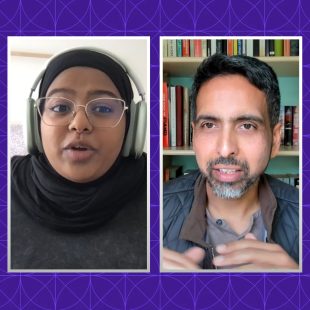
Doha Debates Podcast
Doha Debates Podcast brings together people with starkly different opinions for an in-depth, human conversation that tries to find common ground.

Lana
A podcast in Arabic for today’s generation to discuss their outlook on the world, hosted by Rawaa Augé.

